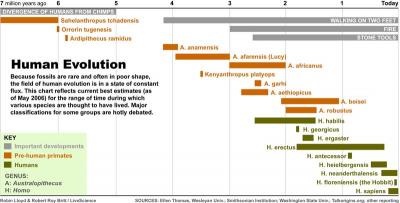Human Ancestors May Have Hit the Ground Running

New findings raise the interesting possibility that the step from a tree-dwelling ape to a terrestrial biped might not have been as drastic as previously thought.
Scientists find muscles gibbons use for climbing and swinging through trees might also help the apes run.
Humans are the upright apes, but much remains unknown as to how our ancestors first found their footing. To shed light on the past, Evie Vereecke at the University of Antwerp in Belgium and her colleagues looked at how modern cousins of humanity such as gibbons and bonobos amble.
For two months, Vereecke's team monitored how four white-handed gibbons at a local zoo strode at speeds ranging from strolls to sprints across a 13-foot-long walkway surrounded with video cameras and loaded with scientific instruments such as force plates and pressure mats.
The gibbons collaborated well, "especially when you rewarded them with some raisins," Vereecke said.
Walking vs. running
While bonobos are our closest relatives and probably have a similar anatomy to our ancestors, gibbons are the most bipedal nonhuman apes, and the researchers wanted to see whether their gaits resembled any of humans.
Walking saves energy by converting the kinetic energy from a step to potential energy as walkers move over their supporting feet, energy that is ready to get recovered back as kinetic energy when walkers move into their next step. Running, on the other hand, stores energy from each bound as elastic energy in the tendons, muscles and ligaments before it gets recycled back as recoil for the next step.
Most legged animals walk at low speeds and run, trot, hop or gallop at high speeds. By monitoring how much force the gibbons stepped down with, the researchers calculated that gibbons almost always seemed to bounce along using the energetics linked with running, even though their footfall patterns were more like those of walks, the scientists reported in the Journal of Experimental Biology.
This suggests the step for humans from a tree-dwelling ape to a terrestrial biped might not have been as drastic as previously thought, Vereecke said.
Hop on down
The bouncy energetics of running makes sense for tree-dwellers, since the stiff-legged motions often associated with walking can shake the unsteady branches the apes might find themselves on.
When it comes to how the ancestors of humans started on their legs, scientists are divided between the terrestrial theory, assuming we became bipedal through a four-legged stage on the ground, or the arboreal theory, that sees the biomechanics of climbing and swinging through trees as potential precursors for bipedalism.
These findings support the arboreal theory, although they do not exclude the terrestrial one.
By Charles Q. Choi
Special to LiveScience
posted: 24 July 2006
01:36 pm ET
Publicado en: http://www.livescience.com/animalworld/060724_gibbons_walking.html
0 comentarios